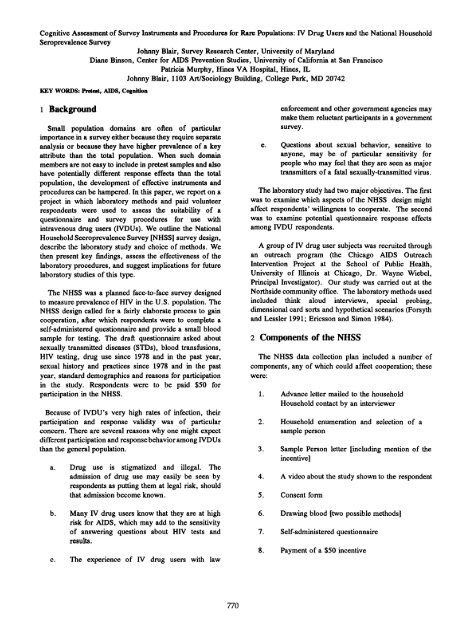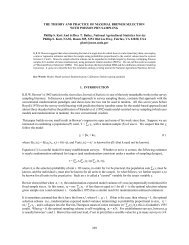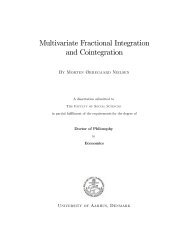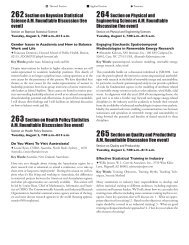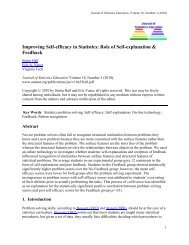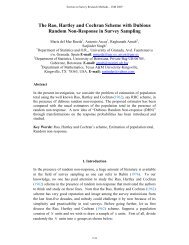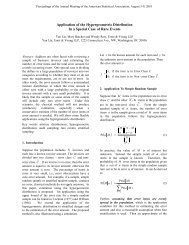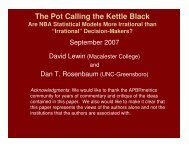Cognitive Assessment of Survey Instruments and Procedures for ...
Cognitive Assessment of Survey Instruments and Procedures for ...
Cognitive Assessment of Survey Instruments and Procedures for ...
Create successful ePaper yourself
Turn your PDF publications into a flip-book with our unique Google optimized e-Paper software.
<strong>Cognitive</strong> <strong>Assessment</strong> <strong>of</strong> <strong>Survey</strong> <strong>Instruments</strong> <strong>and</strong> <strong>Procedures</strong> <strong>for</strong> Rare Populations: IV Drug Users <strong>and</strong> the National Household<br />
Seroprevalence <strong>Survey</strong><br />
Johnny Blair, <strong>Survey</strong> Research Center, University <strong>of</strong> Maryl<strong>and</strong><br />
Diane Binson, Center <strong>for</strong> AIDS Prevention Studies, University <strong>of</strong> Cali<strong>for</strong>nia at San Francisco<br />
Patricia Murphy, Hines VA Hospital, Hines, IL<br />
Johnny Blair, 1103 Art/Sociology Building, College Park, MD 20742<br />
KEY WORDS: Pretest, AIDS, Cognition<br />
1 Background<br />
Small population domains are <strong>of</strong>ten <strong>of</strong> particular<br />
importance in a survey either because they require separate<br />
analysis or because they have higher prevalence <strong>of</strong> a key<br />
attribute than the total population. When such domain<br />
members are not easy to include in pretest samples <strong>and</strong> also<br />
have potentially different response effects than the total<br />
population, the development <strong>of</strong> effective instruments <strong>and</strong><br />
procedures can be hampered. In this paper, we report on a<br />
project in which laboratory methods <strong>and</strong> paid volunteer<br />
respondents were used to assess the suitability <strong>of</strong> a<br />
questionnaire <strong>and</strong> survey procedures <strong>for</strong> use with<br />
intravenous drug users (IVDUs). We outline the National<br />
Household Seeroprevalence <strong>Survey</strong> [NHSS] survey design,<br />
describe the laboratory study <strong>and</strong> choice <strong>of</strong> methods. We<br />
then present key fmdings, assess the effectiveness <strong>of</strong> the<br />
laboratory procedures, <strong>and</strong> suggest implications <strong>for</strong> future<br />
laboratory studies <strong>of</strong> this type.<br />
The NHSS was a planned face-to-face survey designed<br />
to measure prevalence <strong>of</strong> HIV in the U.S. population. The<br />
NHSS design called <strong>for</strong> a fairly elaborate process to gain<br />
cooperation, after which respondents were to complete a<br />
self-administered questionnaire <strong>and</strong> provide a small blood<br />
sample <strong>for</strong> testing. The draft questionnaire asked about<br />
sexually transmitted diseases (STDs), blood transfusions,<br />
HIV testing, drug use since 1978 <strong>and</strong> in the past year,<br />
sexual history <strong>and</strong> practices since 1978 <strong>and</strong> in the past<br />
year, st<strong>and</strong>ard demographics <strong>and</strong> reasons <strong>for</strong> participation<br />
in the study. Respondents were to be paid $50 <strong>for</strong><br />
participation in the NHSS.<br />
Because <strong>of</strong> IVDU's very high rates <strong>of</strong> infection, their<br />
participation <strong>and</strong> response validity was <strong>of</strong> particular<br />
concern. There are several reasons why one might expect<br />
different participation <strong>and</strong> response behavior among IVDUs<br />
than the general population.<br />
Drug use is stigmatized <strong>and</strong> illegal. The<br />
admission <strong>of</strong> drug use may easily be seen by<br />
respondents as putting them at legal risk, should<br />
that admission become known.<br />
b° Many IV drug users know that they are at high<br />
risk <strong>for</strong> AIDS, which may add to the sensitivity<br />
<strong>of</strong> answering questions about HIV tests <strong>and</strong><br />
results.<br />
The experience <strong>of</strong> IV drug users with law<br />
en<strong>for</strong>cement <strong>and</strong> other government agencies may<br />
make them reluctant participants in a government<br />
survey.<br />
Questions about sexual behavior, sensitive to<br />
anyone, may be <strong>of</strong> particular sensitivity <strong>for</strong><br />
people who may feel that they are seen as major<br />
transmitters <strong>of</strong> a fatal sexually-transmitted virus.<br />
The laboratory study had two major objectives. The first<br />
was to examine which aspects <strong>of</strong> the NHSS design might<br />
affect respondents' willingness to cooperate. The second<br />
was to examine potential questionnaire response effects<br />
among IVDU respondents.<br />
A group <strong>of</strong> IV drug user subjects was recruited through<br />
an outreach program (the Chicago AIDS Outreach<br />
Intervention Project at the School <strong>of</strong> Public Health,<br />
University <strong>of</strong> Illinois at Chicago, Dr. Wayne Wiebel,<br />
Principal Investigator). Our study was carried out at the<br />
Northside community <strong>of</strong>fice. The laboratory methods used<br />
included think aloud interviews, special probing,<br />
dimensional card sorts <strong>and</strong> hypothetical scenarios (Forsyth<br />
<strong>and</strong> Lessler 1991; Ericsson <strong>and</strong> Simon 1984).<br />
2 Components <strong>of</strong> the NHSS<br />
The NHSS data collection plan included a number <strong>of</strong><br />
components, any <strong>of</strong> which could affect cooperation; these<br />
were:<br />
Advance letter mailed to the household<br />
Household contact by an interviewer<br />
. Household enumeration <strong>and</strong> selection <strong>of</strong> a<br />
sample person<br />
. Sample Person letter [including mention <strong>of</strong> the<br />
incentive]<br />
4. A video about the study shown to the respondent<br />
5. Consent <strong>for</strong>m<br />
° Drawing blood [two possible methods]<br />
Self-administered questionnaire<br />
Payment <strong>of</strong> a $50 incentive<br />
770
3 Choice <strong>of</strong> Methods<br />
For reasons <strong>of</strong> access to subjects <strong>and</strong> the limited budget<br />
<strong>of</strong> the laboratory study, it was clear that the possible<br />
sample size would be small. Yet the number <strong>of</strong> potential<br />
issues <strong>and</strong> the large number <strong>of</strong> NHSS procedures <strong>and</strong><br />
documents would require a relatively large amount <strong>of</strong><br />
in<strong>for</strong>mation from each subject. Also, we sought not only<br />
to determine sources <strong>of</strong> survey problems particular to IV<br />
drug users, but to gain some insights into possible reasons<br />
<strong>for</strong> the identified problems. So obtaining some in<strong>for</strong>mation<br />
about response <strong>for</strong>mation <strong>and</strong> perceptions <strong>of</strong> survey<br />
questions <strong>and</strong> procedures would be useful. Lastly, we did<br />
not want to structure the laboratory protocol so tightly that<br />
unanticipated issues relevant to IVDU cooperation <strong>and</strong><br />
response effects could not emerge.<br />
For these reasons, <strong>and</strong> the experiences <strong>of</strong> other<br />
researchers using laboratory methods (Royston, 1989;<br />
Royston et al. 1986) we thought that a qualitative approach<br />
in a "laboratory" seating would maximize our ability:<br />
a. to probe responses thoroughly;<br />
b. to use verbal protocols to examine response<br />
<strong>for</strong>mation;<br />
to create an atmosphere in which subjects would<br />
be willing to discuss reservations or suspicions<br />
about the NHSS survey plans; <strong>and</strong><br />
d. to allow the research to proceed in an iterative<br />
fashion-that is, as interviews were completed <strong>and</strong><br />
no points came up or old issues were not yielding<br />
additional in<strong>for</strong>mation, the focus <strong>of</strong> subsequent<br />
interviews could be shit~ed.<br />
process <strong>of</strong> the NHSS (advance letter, household screening,<br />
consent <strong>for</strong>m, video, <strong>and</strong> questionnaire), [the blood draw<br />
could, <strong>of</strong> course, only be described <strong>and</strong> discussed] <strong>and</strong> to<br />
get reactions to the hypothetical experience <strong>of</strong> being<br />
contacted <strong>and</strong> selected <strong>for</strong> the NHSS, <strong>and</strong> exposed to each<br />
<strong>of</strong> its stages <strong>and</strong> documents. Although this approach was<br />
followed in the first 11 interviews, questions about the<br />
household screening <strong>and</strong> consent <strong>for</strong>m components <strong>of</strong> the<br />
NHSS were dropped because these seemed difficult <strong>for</strong><br />
respondents to discuss hypothetically. Showing <strong>of</strong> the video<br />
<strong>and</strong> questions about the method <strong>of</strong> drawing blood samples<br />
were discontinued when interviews were no longer yielding<br />
new in<strong>for</strong>mation. Although simulation <strong>of</strong> the household<br />
listing was discontinued, subjects were questioned in<br />
general about issues related to the listing <strong>and</strong> to obtaining<br />
sample coverage <strong>of</strong> IV drug users.<br />
We should also note that the content <strong>of</strong> the laboratory<br />
interviews varied somewhat even when the same protocol<br />
was used because the protocol served as a general guide,<br />
not a series <strong>of</strong> questions administered verbatim. We ot~en<br />
pursued topics raised by subjects that were not in the<br />
laboratory protocol. Although we tried in each interview<br />
to cover all <strong>of</strong> the topics specified in the protocol, the<br />
extent to which each was explored depended on how<br />
responsive the subject was.<br />
Below is an outline <strong>of</strong> the major components <strong>of</strong> the<br />
initial laboratory protocol, <strong>and</strong> the objective <strong>of</strong> each one.<br />
Outline <strong>of</strong> Laboratory Protocol<br />
NHSS<br />
Laboratory<br />
Component Method Objective<br />
The methods selected <strong>for</strong> use were: concurrent <strong>and</strong><br />
retrospective think aloud; follow-up probing on each<br />
question; dimensional card sorts; hypothetical reactions to<br />
NHSS procedures <strong>and</strong> materials. (See Figure 1)<br />
4 Laboratory Protocol<br />
It is important to keep in mind that in the laboratory<br />
research, although interviewers were guided by a written<br />
laboratory protocol, its content changed over time. An<br />
iterative process was used in which the experience from<br />
laboratory interviews brought out additional issues, <strong>and</strong> we<br />
revised the laboratory protocol to include investigation <strong>of</strong><br />
those issues• Laboratory interviews also sometimes<br />
suggested better questions or probes which were<br />
incorporated as well. Finally, when there seemed to be no<br />
variance in responses to an issue or question, the item was<br />
dropped from the laboratory protocol, or the time allotted<br />
to it was reAueexl,<br />
• An advance<br />
letter<br />
• Household<br />
contact by an<br />
interviewer<br />
• Household<br />
enumeration <strong>and</strong><br />
selection <strong>of</strong> a<br />
sample person<br />
Probing to<br />
determine<br />
hypothetical<br />
<strong>and</strong> personal<br />
reactions<br />
Probing to<br />
determine<br />
hypothetical<br />
<strong>and</strong> personal<br />
reactions<br />
Probing to<br />
determine<br />
hypothetical<br />
<strong>and</strong> personal<br />
reactions<br />
Assess legitimacy<br />
& suspicion<br />
Letter clarity<br />
Willingness to<br />
allow access<br />
Inclusion <strong>of</strong> WDU<br />
in HH listing<br />
O~r initial plan was to take subjects through the entire<br />
771
Outline <strong>of</strong> Protocol (con't.)<br />
NHSS<br />
Laboratory<br />
Component Method Objective<br />
. Sample Person<br />
letter [including<br />
mention <strong>of</strong><br />
[incentive]<br />
• Video<br />
• Consent <strong>for</strong>m<br />
• Drawing blood<br />
HIV testing<br />
• Selfo<br />
administered<br />
questionnaire<br />
Probing to<br />
determine<br />
hypothetical<br />
<strong>and</strong> personal<br />
reactions<br />
Probing to<br />
determine<br />
hypothetical<br />
<strong>and</strong> personal<br />
reactions<br />
Probing to<br />
determine<br />
hypothetical<br />
<strong>and</strong> personal<br />
reactions<br />
Probing to<br />
determine<br />
hypothetical<br />
<strong>and</strong> personal<br />
reactions<br />
Probing to<br />
determine<br />
hypothetical<br />
<strong>and</strong> personal<br />
reactions.<br />
Think aloud.<br />
Vocabulary card<br />
sort. Focused<br />
probing.<br />
Le41er clarity<br />
Incentive effect<br />
Clarity <strong>of</strong> survey<br />
importance &<br />
goals<br />
Belief in<br />
anonymity clarity<br />
Willingness to<br />
provide blood<br />
sample using<br />
different methods<br />
Underst<strong>and</strong>ing<br />
Clarity<br />
WiUingncss to<br />
provide<br />
in<strong>for</strong>mation<br />
. Method <strong>of</strong> Probing to Acceptance <strong>of</strong><br />
payment <strong>of</strong> determine method<br />
incentive<br />
hypothetical<br />
<strong>and</strong> personal<br />
reactions<br />
5 Sampling <strong>and</strong> interviewing<br />
A group <strong>of</strong> known intravenous drug users was recruited<br />
by the Chicago Outreach Project. Subjects were no_.3t part <strong>of</strong><br />
the Outreach Project itself, but were neighborhood<br />
residents known to the outreach workers. A total <strong>of</strong> 36<br />
people were interviewed. Of these, 26 were male <strong>and</strong> 10<br />
were female. Almost two-thirds (23) <strong>of</strong> the subjects were<br />
Black, while the remainder (13) were White. The mean<br />
age <strong>of</strong> subjects was 38.9 years. Nineteen subjects were 30-<br />
39 years old at the time <strong>of</strong> the interview; 4 were 24-30<br />
years old, <strong>and</strong> the remaining 13 were 40-60 years <strong>of</strong> age.<br />
Of the 36 subjects, 15 had less than a high school<br />
education, <strong>and</strong> 5 had less than 9 years <strong>of</strong> education. Eight<br />
subjects had either completed high school or had a GED.<br />
Some college was reported by 13 people.<br />
Most individual laboratory interviews were conducted<br />
one-on-one, in private interviewing rooms equipped with<br />
desks <strong>and</strong> chairs. Interviews were tape-recorded <strong>and</strong><br />
ranged in length from 30 minutes to 2 hours. Most<br />
interviews lasted about 45 minutes. All interviews were<br />
audio-tape-recorded. Subjects were paid $20.<br />
A portable video cassette player was used to show the<br />
NHSS video produced by NCHS to 13 subjects. To<br />
simplify logistics, the NHSS video <strong>of</strong>ten was shown to two<br />
subjects together, but with the subsequent laboratory<br />
interviews conducted separately.<br />
6 Data Analysis<br />
Three procedures were used to prepare the interviews <strong>for</strong><br />
analysis: (a) abstracting the interviews, using a<br />
st<strong>and</strong>ardized <strong>for</strong>m; (b) tallying results <strong>of</strong> the card sorting<br />
task used to identify words that subjects found difficult to<br />
read or underst<strong>and</strong>; <strong>and</strong> (c) discussing the interviews as a<br />
research team following each interviewing session, to<br />
record in<strong>for</strong>mation <strong>and</strong> refine the protocol or procedures.<br />
7 Results<br />
a. NHSS findings<br />
Regarding participation in the NHSS, the main<br />
concerns <strong>of</strong> the IV drug users in this project were<br />
suspicions about why they might have been chosen <strong>for</strong> such<br />
a study, <strong>and</strong> whether anonymity would truly be maintained.<br />
Since IV drug users know that they are <strong>of</strong>ten identified on<br />
various fists as known drug users, it is easy <strong>for</strong> them to<br />
think that they were chosen from some such list• Some<br />
subjects also suggested that IVDU respondents might think<br />
that they were selected <strong>for</strong> the NHSS survey because they<br />
had AIDS.<br />
An unanticipated issue raised was the role <strong>of</strong> the NHSS<br />
as a source <strong>of</strong> education about AIDS. A number <strong>of</strong> the<br />
subjects felt that if education about risk behaviors could be<br />
provided as part <strong>of</strong> the NHSS, it would be a major<br />
incentive to participate.<br />
The last key issue related to the decision to participate is<br />
the method <strong>of</strong> drawing blood. The condition <strong>of</strong> the veins<br />
<strong>of</strong> many IV drug users make st<strong>and</strong>ard techniques <strong>for</strong><br />
drawing blood difficult, painful, or impossible. The<br />
emphasis in the NHSS on using venipuncture (versus finger<br />
stick) <strong>for</strong> the blood draw was seen as a strongly negative<br />
factor <strong>and</strong> a disincentive <strong>for</strong> participation in the NHSS.<br />
772
Regarding response bias, a number <strong>of</strong> problems arose<br />
from the self-administered nature <strong>of</strong> the questionnaire<br />
which were not directly related to the respondent's IVDU<br />
status. These issues concerned mainly reading ability. The<br />
card sort turned up expected problems with words like<br />
"seroprevalence" <strong>and</strong> "hemophilia", but also with the<br />
words "anal," "marital" <strong>and</strong> "assurances." Further, it was<br />
found that subjects might underst<strong>and</strong> one grammatical <strong>for</strong>m<br />
<strong>of</strong> a word but not another. For example, "vagina" was<br />
known by most subjects, but "vaginal" was not.<br />
There were also problems with the questions on drug<br />
use, sex practices, <strong>and</strong> HIV test results which seem to<br />
differ <strong>for</strong> IV drug users compared to the general<br />
population. The terminology <strong>for</strong> drug use practices was<br />
sometimes inappropriate. For example, "street drugs" was<br />
not uni<strong>for</strong>mly interpreted. For some subjects it meant drugs<br />
<strong>of</strong> low quality, while <strong>for</strong> others it meant drugs excluding<br />
illegally obtained pharmaceutical drugs.<br />
The questions about sharing needles were problematic.<br />
IVDUs who cleaned their "works" be<strong>for</strong>e sharing them did<br />
not want to be grouped, as the draR questionnaire did, with<br />
IVDUs who shared needles without fn'st cleaning them.<br />
Lastly, the lack <strong>of</strong> skip instructions, thought to simplify<br />
the instrument, confused <strong>and</strong> irritated some subjects who<br />
had to answer inappropriate items- even though Not<br />
Applicable N.A. (which was itself not always understood)<br />
was available to them. For example, many heterosexual<br />
men resented being asked about sex with other men.<br />
b. Methodological findings<br />
Two aspects <strong>of</strong> subjects' reactions should be<br />
mentioned: to the general laboratory interview procedures<br />
<strong>and</strong> to the attempts to simulate the NHSS survey. For the<br />
most part, the laboratory interviews worked well, but <strong>for</strong><br />
several subjects it was not absolutely clear, at the outset,<br />
what was being asked <strong>of</strong> them. The notion <strong>of</strong> discussing,<br />
rather than just providing, their responses took some<br />
getting used to. This was especially the case <strong>for</strong> those who<br />
had previously participated in traditional surveys. We<br />
learned quickly that more time was needed at the start <strong>of</strong><br />
each session to explain what we were trying to do be<strong>for</strong>e<br />
launching into the laboratory interview itself.<br />
As noted above, initially we had planned to go through<br />
all NHSS materials in sequence, explaining as we went<br />
along how the NHSS would bc conducted, <strong>and</strong> getting<br />
respondent reactions. This was ab<strong>and</strong>oned aRer two<br />
interviews. These hypothetical scenarios proved very<br />
difficult <strong>for</strong> the subjects, as well as adding to the session<br />
length, which was already quite long.<br />
The hypothetical aspect <strong>of</strong> the protocol took two <strong>for</strong>ms.<br />
First, respondents were asked how they thought they might<br />
personally react to a particular component <strong>of</strong> the NHSS if<br />
they were actually confronted with it. Second, they were<br />
asked how they thought other people might react to the<br />
same component on NHSS. Respondents had trouble with<br />
both situations, but mainly with other people's possible<br />
reactions.<br />
A minor point, but worth mentioning <strong>for</strong> this population,<br />
is that even with careful recruitment, a few respondents<br />
arrived "high" <strong>for</strong> the session or were obviously in need <strong>of</strong><br />
drugs <strong>and</strong> eager to be done with the session, obtain the<br />
mone, tary incentive <strong>and</strong> leave. It would be difficult <strong>for</strong><br />
interviewers not used to dealing with this population to<br />
judge respondent competence be<strong>for</strong>e actually attempting the<br />
interview. Having someone available who is used to<br />
working with this population was very important.<br />
Those problems having been given, it should be noted<br />
that most respondents were quite helpful <strong>and</strong> capable.<br />
There was little if anything in their reactions to the<br />
methods themselves that we would attribute to their being<br />
drug users. We feel that the outcome was highly<br />
successful.<br />
One method that was both simple <strong>and</strong> effective was the<br />
card sort. It was easy to explain to respondents, did not<br />
take long to conduct, <strong>and</strong> provided a simple measure <strong>of</strong><br />
perceived vocabulary complexity. As far as we could tell,<br />
respondents did not see the task itself as sensitive. This<br />
might well have been because we allowed them to note<br />
both words they did not underst<strong>and</strong> <strong>and</strong> words that they<br />
thought many people might not underst<strong>and</strong>. While a<br />
clearer measurement would result from limiting the "sort"<br />
to words that the respondent himself/herself did not<br />
underst<strong>and</strong>, we think that the approach we chose was more<br />
helpful in this interview context.<br />
In the think-aloud procedure, respondents were asked to<br />
think aloud concurrently <strong>and</strong> also were asked aRer each<br />
answer, "How did you come up with your answer?" or<br />
"What were you thinking about?" This was useful<br />
especially in regard to the NHSS reference periods. A<br />
respondent's failure to mention how the time period was<br />
used in <strong>for</strong>mulating a response suggests that the reference<br />
period was not being considered, at least this seemed to<br />
happen frequently <strong>for</strong> the period since 1978.<br />
There may be some tendency in retrospective thinking<br />
aloud to fabricate--aRcr the fact <strong>of</strong> response <strong>for</strong>mation--a<br />
more detailed <strong>and</strong> elaborate response process than probably<br />
occurred in the amount <strong>of</strong> time taken to answer a question.<br />
As with other populations where, in our experience, this<br />
seems to occur, the line between reporting-vs, explaining<br />
or justifying--response <strong>for</strong>mation may bca hard one to<br />
detect.<br />
One has to be especially careful not to use leading<br />
probes in such an open-<strong>for</strong>matted, conversational setting.<br />
For these respondents, the $20 they were paid is not a<br />
trivial amount. Under these circumstances some<br />
respondents may look <strong>for</strong> clues <strong>for</strong> how to "please" the<br />
773
interviewer. One must take care that the probes do not<br />
inadvertently provide such clues, since many drugs users<br />
are very practiced at "reading" <strong>and</strong> manipulating personal<br />
interactions.<br />
Respondents were willing to discuss their reservations or<br />
suspicions about the NHSS, though this openness might be<br />
owed to the neighborhood rapport <strong>and</strong> reputation <strong>of</strong> the<br />
Chicago Outreach Project, rather than to our particular<br />
methods. Still, this approach certainly allowed respondents<br />
the opportunity to express their reservations <strong>and</strong>/or<br />
suspicions about NHSS, which other, more structured,<br />
methods might not do as well.<br />
Here again, the caution about the respondents' desire to<br />
please applies. Although purely a subjective judgment, we<br />
did not sense a reluctance <strong>of</strong> respondents to express their<br />
concerns in this area.<br />
Adjusting the focus <strong>of</strong> subsequent laboratory interviews<br />
based on new issues arising or old issues not yielding new<br />
in<strong>for</strong>mation did work well, <strong>and</strong> was not just valuable, but<br />
essential, to the study. It also allowed us to take maximum<br />
advantage <strong>of</strong> the small sample size. We should point out,<br />
however, that these ongoing laboratory protocol<br />
adjustments do not come without some costs <strong>and</strong> cautions.<br />
Much care has to be given to communicating the<br />
modifications <strong>of</strong> the laboratory protocol to all interviewers.<br />
Otherwise, not only are the discussions after the interview<br />
sessions based on different experiences, but the direction<br />
that further modifications should take becomes problematic.<br />
More important, changing the protocol can potentially<br />
affect how the quantitative data should be interpreted. Not<br />
only does the sample base vary as items are dropped or<br />
added, but the context differs as well. To the extent that<br />
the protocol, as a type <strong>of</strong> survey instrument, has its own<br />
context effects, the quantitative data may be affected- even<br />
<strong>for</strong> items that, in themselves, remain the same. For<br />
example, at the very start <strong>of</strong> laboratory data collection,<br />
discussion <strong>of</strong> the advance letter, sample person letter <strong>and</strong><br />
consent <strong>for</strong>m occupied a major part <strong>of</strong> the interview. All<br />
<strong>of</strong> these items focus, in various ways, on the idea <strong>of</strong><br />
anonymity. That is, as part <strong>of</strong> the focus interview they<br />
convey in<strong>for</strong>mation about anonymity. And, as part <strong>of</strong><br />
going through the NHSS survey questionnaire, we raise<br />
issues about anonymity.<br />
Later in the data collection period, the advance letter, the<br />
sample person letter, <strong>and</strong> the consent <strong>for</strong>m were dropped<br />
or given less time. As a consequence, the in<strong>for</strong>mation they<br />
conveyed about anonymity was reduced as well. In this<br />
changed context, respondent reaction to issues <strong>of</strong><br />
anonymity that come up as part <strong>of</strong> going through the<br />
questionnaire may be different later in the data collection<br />
period than earlier. Hence, analysis <strong>of</strong> an item, after some<br />
protocol modification, may not be comparable to prior<br />
analysis.<br />
8 Suggestions <strong>for</strong> similar research<br />
In planning future studies <strong>of</strong> this type, several points<br />
are worth consideration:<br />
Some <strong>of</strong> the things found are no different <strong>for</strong><br />
IVDUs than <strong>for</strong> the general population. In the<br />
hypothetical <strong>and</strong> probing parts <strong>of</strong> the laboratory<br />
protocols, IVDUs need to be reminded that the<br />
interest is in how IVDUs might respond to<br />
aspects <strong>of</strong> the survey.<br />
• Some pretesting is advisable, even when the<br />
study is small. For this laboratory study,<br />
pretesting would have likely shown the need to<br />
spend more time exphining the respondent task<br />
in focus interviews. The difficulty subjects have<br />
dealing with hypothetical situations may also have<br />
been determined. Pretesting would also reduce<br />
the need <strong>for</strong> later changes in the laboratory<br />
protocol.<br />
Great care must be taken to set tasks clearly.<br />
Maybe a video <strong>of</strong> such a laboratory interview<br />
being conducted could be developed <strong>and</strong> shown<br />
to respondents while they are waiting to begin.<br />
It would be necessary to use a generic<br />
presentation to avoid respondents parroting back<br />
what they see in the video. But a video might be<br />
a way to clarify a novel task that can easily be<br />
misunderstood.<br />
The sample size should allow <strong>for</strong> some "dud"<br />
sessions due to the respondent being either "high"<br />
or otherwise unable to per<strong>for</strong>m the required<br />
tasks. Respondents should be screened<br />
immediately prior to the session--by someone<br />
used to working with drug users.<br />
0 The uni<strong>for</strong>mity <strong>and</strong> non-directionality <strong>of</strong> probes<br />
need careful attention.<br />
Some thought should be given to possible context<br />
effects in the protocol itself, especially if changes<br />
in the laboratory protocol are anticipated during<br />
the data collection period. If resources permit, a<br />
control group, in which the protocol either does<br />
not change or changes one chronological step<br />
behind the experimental group, might be<br />
effective. Each time a change was made in the<br />
laboratory protocol, some cases can be done<br />
without the change <strong>for</strong> the sole purpose <strong>of</strong><br />
looking <strong>for</strong> response variation due to the altered<br />
context. This might, however, require larger<br />
samples than usual <strong>for</strong> this type <strong>of</strong> research.<br />
• When a large number <strong>of</strong> survey materials need to<br />
be tested, some consideration might be given to<br />
774
<strong>and</strong>omizing various non-core materials across<br />
respondents. However, again, some attention to<br />
possible context effects is necessary.<br />
In sum, then, we found that the use <strong>of</strong> laboratory<br />
methods <strong>and</strong> volunteer respondents can be a useful tool <strong>for</strong><br />
investigation <strong>of</strong> both response effects- as many other<br />
researchers have shown (Royston et al. 1986; Royston<br />
1989)- <strong>and</strong> also effective <strong>for</strong> investigating issues <strong>of</strong><br />
participation decisions <strong>and</strong> other planned survey<br />
procedures. While this study focused on a single population<br />
domain, the methods would seem generally applicable to<br />
other groups.<br />
R may be useful to note here that survey researchers<br />
have generally used methods borrowed from cognitive<br />
psychology in two ways. First, there has been research in<br />
which theories from cognitive psychology have been used<br />
in experimental designs to investigate the survey response<br />
process. Second, as in this project, the methods <strong>of</strong><br />
cognitive psychology- especially the think aloud<br />
procedures- have been used in traditional survey settings<br />
as simply additional tools <strong>for</strong> improving a particular<br />
instrument or survey design. While the <strong>for</strong>mer approach<br />
is most likely to have a lasting impact on advancing survey<br />
research as a science, we think that the second use is also<br />
a valuable tool <strong>for</strong> practitioners to underst<strong>and</strong> the thoughts<br />
<strong>and</strong> perceptions <strong>of</strong> potential respondents. However, it is<br />
important to note that in the latter case, the generalizability<br />
<strong>of</strong> the results may be severely limited.<br />
References<br />
Ericsson, K.A. <strong>and</strong> Simon, H.A. (1984) Protocol<br />
Analysis, The MIT Press.<br />
Forsyth, B. <strong>and</strong> Lessler, J.T. (1991) "A Taxonomy <strong>of</strong><br />
<strong>Cognitive</strong> Laboratory Methods" Workshop on Cognition<br />
<strong>and</strong> <strong>Survey</strong> Methodology Utrecht, Netherl<strong>and</strong>s.<br />
Royston, P. (1989) "Using Intensive Interviews to<br />
Evaluate Questions" in Fowler, F.J. ed Health <strong>Survey</strong><br />
Research Methods: Conference Proceedings U.S. Dept. <strong>of</strong><br />
Health <strong>and</strong> Human Services pp. 3-7.<br />
Royston, P., Bercini, D., Sirken, M., et al. (1986)<br />
"Questionnaire Design Research Laboratory" Proceedings<br />
<strong>of</strong> th.e Section on <strong>Survey</strong> Research Methods <strong>of</strong> the<br />
American Statistical Association pp. 703-707.<br />
Figure 1: Laboratory Methods<br />
Concurrent <strong>and</strong> retrospective think aloud<br />
respondents are asked to describe out loud what<br />
they are thinking as they respond to each question<br />
Follow-up probing on each question<br />
aider each response, the interviewer discusses<br />
each question's meaning <strong>and</strong> clarity with the<br />
respondent<br />
Dimensional card sorts<br />
respondents are given a set <strong>of</strong> index cards on<br />
which are written words from the questionnaire.<br />
they are asked to sort the cards into two groups<br />
Hypothetical reactions: respondent vs others<br />
a survey procedure-- such as an interviewer<br />
arriving at the respondent's household requesting<br />
survey participation-- is described, the subject is<br />
asked how he [or others like himself] would<br />
react.<br />
775


